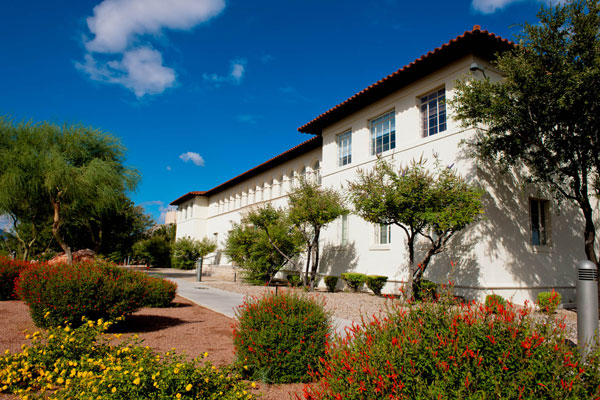|
It was 1930, the middle of the Great Depression, and southern Nevada needed a town. The Boulder Canyon Project Act, signed two years earlier, appropriated $165 million for construction of a dam on the Colorado River. Since then, unemployed workers had been finding their way to Las Vegas and to makeshift camps on the river near the dam site. However, the thousands of workers and their families needed a more permanent home, and that home would also be the headquarters for the agency overseeing the project, the Bureau of Reclamation.
Secretary of the Interior, Ray Wilbur, settled the question of where that home would be when he announced the building of a model city in the desert overlooking the Colorado River. The town became Boulder City, and the beige-colored, tile-roofed building at the peak of the hill became the Reclamation Administration Building.
If fences make for good neighbors, then open spaces make for even better ones. As a planned community, Boulder City featured parks and plazas with abundant landscaping. While two of the three original plazas have become part of the downtown area, the large green space on the hillside in front of the Reclamation building became Wilbur Square Park. If events like Boulder City’s annual Art in the Park didn’t exist, you’d have to invent them just as an excuse to enjoy the park’s expanse of grassy lawn and stately trees.

Since Boulder City’s incorporation in 1960, when the government formally relinquished management of the town, Reclamation continues as one of the town’s largest employer’s, with about 500 people working in Boulder City and at Hoover Dam. Hoover Dam is one of the area’s preeminent attractions–not to mention the world’s major source of dam jokes–with more than 800,000 visitors each year passing through Boulder City on their way to and from the dam.
The original administration building is still going strong as Reclamation’s “oldie but goodie” headquarters in Boulder City, but the agency has added several other buildings over the years to accommodate its changing work force. In designing and constructing recent buildings, Reclamation worked with Boulder City and the Nevada State Historic Preservation office to ensure that the new buildings would fit in with the area’s distinctive 1930s historic appearance, while meeting modern construction and energy efficiency standards.
In 1996, Reclamation partnered with Boulder City, the National Park Service, and other local and federal entities to develop the 35-mile long River Mountains Loop Trail, which was completed in 2011 and provides hikers, bikers and equestrians plenty of opportunity to enjoy the local red rock scenery and test the limits of their hydration systems. A less strenuous and more raucous local activity is the annual C.A.S.T. for Kids fishing day at Lake Mead. More than 30 local agencies and nearly 100 volunteers support the event, which is in its fifteenth year.
Reclamation also hosts a Job Shadowing Day in Boulder City for local students, which shines some light on such questions as, “How can I become an engineer?” “Is the government really here to help?” and “Are there giant alien robots hidden in Hoover Dam?” Incidentally, the answers are, “Do well in school” “We try” and “Not that we know of.”
Regional Director Terry Fulp said that being a good neighbor is important to Reclamation. “Although Reclamation is just one of Boulder City’s many residents, we’re one of the most visible, and our actions potentially have a big impact on the area,” Fulp said. “A lot of our employees, including me, live in Boulder City, so it’s important to us that we do our part toward enhancing the area’s quality of life.”
|


